Edgar Allan Poe’s “The Black Cat” is a chilling tale of guilt, madness, and violence, exploring the darker aspects of human nature through a haunting narrative.
1.1 Background and Historical Context
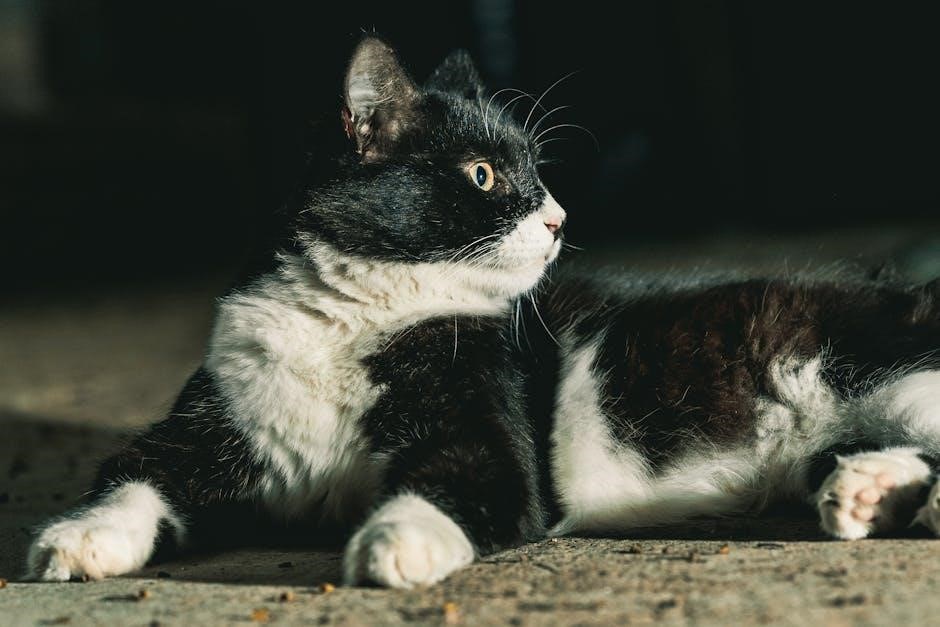
Edgar Allan Poe’s “The Black Cat” was first published in 1843, during the height of Gothic literature’s popularity. The story reflects the cultural fascination with death, morality, and the supernatural prevalent in 19th-century America. Poe, a master of dark themes, crafted this tale amid personal struggles, including the illness of his wife, Virginia, which may have influenced its somber tone. The narrative’s exploration of guilt, madness, and violence aligns with the era’s psychological intrigue. Historically, the story is significant as it showcases Poe’s ability to blend horror with philosophical introspection, solidifying his place in American literary history. Its enduring appeal lies in its universal themes, transcending time and cultural boundaries.
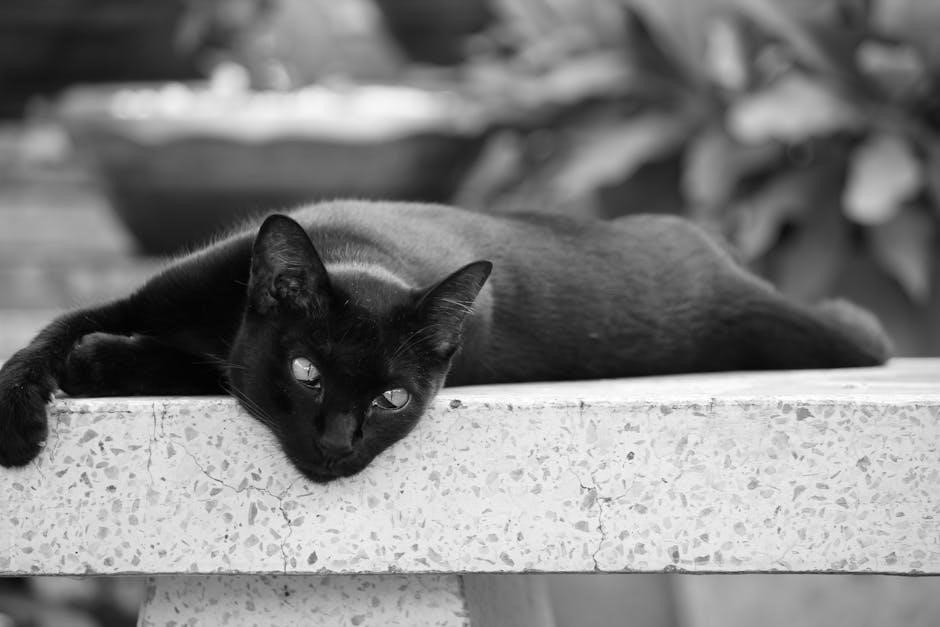
1.2 Significance of the Story in Edgar Allan Poe’s Works
“The Black Cat” holds a prominent place in Edgar Allan Poe’s oeuvre, exemplifying his mastery of psychological horror and the exploration of the darker aspects of human nature. The story is often paired with “The Tell-Tale Heart” due to its similar themes of guilt, madness, and the unreliable narrator. It showcases Poe’s ability to craft suspenseful narratives that delve into the complexities of the human psyche. The tale’s focus on violence and its consequences further cements Poe’s reputation as a pioneer of Gothic literature. Additionally, the story’s use of symbolism, particularly the black cat itself, underscores Poe’s innovative storytelling techniques, making it a cornerstone of his literary legacy and a favorite among scholars and readers alike.
Plot Summary of “The Black Cat”
The story follows a narrator’s descent into madness, detailing his cruelty to his black cat, Pluto, and the eerie consequences that unfold, exploring themes of guilt and violence.
2.1 Key Events and Narrative Structure
The story begins with the narrator introducing his beloved black cat, Pluto, and their deep bond. However, as the narrator descends into alcoholism and madness, his affection turns to cruelty. In a fit of rage, he mutilates Pluto, leading to the cat’s disappearance. Later, a mysterious black cat appears, resembling Pluto, and the narrator’s guilt intensifies. The cat’s presence haunts him, culminating in a tragic ending where the narrator kills his wife and entombs her with the cat, who reveals his guilt to the police. The narrative structure builds suspense through a non-linear, first-person account, emphasizing the narrator’s unreliable perspective and the dark, eerie atmosphere.
2.2 The Climax and Ending: Analysis of the Final Scenes
The climax of “The Black Cat” occurs when the narrator, driven by madness, kills his wife with an axe and entombs her body in the basement wall. The black cat, which has been a constant symbol of guilt, is entombed alongside her. When the police arrive to investigate, the cat’s cries lead them to the wall, revealing the horrific crime. The narrator’s breakdown and the cat’s haunting presence underscore the themes of guilt, madness, and the inescapability of one’s actions. The ending leaves a chilling impression, emphasizing the narrator’s psychological unraveling and the dark consequences of his violence.
Key Elements of the Story
The black cat symbolizes death and guilt, while the narrator’s psychological unraveling drives the dark, violent plot, exploring themes of madness and cruelty.
3.1 The Black Cat as a Symbol
The black cat, Pluto, serves as a potent symbol of death, ill omen, and the supernatural. Its presence foreshadows the narrator’s descent into madness and the tragic events that unfold. The cat’s mysterious behavior and eventual mutilation mirror the narrator’s inner turmoil and guilt. Pluto’s reappearance in the basement, decomposing yet intact, symbolizes the inescapability of death and the narrator’s ultimate doom. The black cat embodies the dark, irrational forces that drive the narrative, highlighting themes of cruelty and the uncontrollable nature of fate. Its role as a symbol underscores Poe’s mastery of using animals to represent the darker aspects of human psychology and the inevitability of mortality.
3.2 The Narrator’s Psychological State and Motivations
The narrator of “The Black Cat” is an unreliable, self-destructive character driven by alcoholism and a deep-seated cruelty. His motivations stem from a twisted sense of control and dominance, evident in his brutal treatment of Pluto and his wife. The narrator’s psychological deterioration is marked by paranoia, guilt, and a refusal to accept responsibility for his actions. His descent into madness is accelerated by the mysterious reappearance of the black cat, which he perceives as a tormentor. The narrator’s actions are fueled by a combination of rage, fear, and a delusional belief in his own innocence, ultimately leading to his downfall. His instability underscores the story’s themes of mental decay and the consequences of unchecked violence.
Themes in “The Black Cat”
Guilt, madness, and cruelty are central themes, as the narrator’s descent into psychological turmoil and violence highlights the destructive power of unchecked emotions and moral decay.
4.1 Guilt, Madness, and the Unreliable Narrator
The narrator’s unreliability stems from his guilt and madness, as he rationalizes his cruel actions, creating a blurred line between reality and delusion. His psychological instability is evident in his contradictory emotions towards the black cat, Pluto, oscillating between affection and hatred. The narrator’s descent into madness is marked by his inability to accept responsibility for his actions, leading to a cycle of self-destruction. This theme underscores Poe’s exploration of the human psyche, revealing how guilt can consume and destroy an individual. The unreliable narration heightens the story’s tension, leaving readers questioning the truth behind the horrific events.
4.2 Cruelty, Violence, and Their Consequences
Poe’s “The Black Cat” delves into the darker aspects of human nature, emphasizing the devastating consequences of unchecked cruelty and violence. The narrator’s brutal treatment of his pets and wife illustrates a descent into moral depravity, driven by alcoholism and a lack of empathy. The mutilation of Pluto and the eventual murder of his wife symbolize the destructive power of unchecked rage. These acts of violence not only lead to the narrator’s downfall but also serve as a grim reminder of the irreversible damage caused by cruelty. The story underscores the idea that violence perpetuates itself, ultimately consuming the perpetrator and leaving only guilt and despair in its wake.

Symbolism in the Story
The black cat symbolizes death and ill omen, while the basement represents buried secrets and guilt, highlighting the story’s dark themes of fate and retribution.
5.1 The Black Cat as a Symbol of Death and Ill Omen
The black cat in Poe’s story is a potent symbol of death and ill omen, foreshadowing the tragic events that unfold. Its mysterious presence and the narrator’s violent actions toward it underscore the dark, foreboding atmosphere. The cat’s reappearance after the narrator’s wife’s death further solidifies its role as a harbinger of doom. This symbolism is central to the story’s exploration of guilt, madness, and the supernatural, making the black cat an enduring and haunting image in Gothic literature.
5.2 The Role of the Basement and the Final Revelation
The basement in “The Black Cat” serves as a symbolic space of concealment and revelation, where the narrator’s darkest secrets are uncovered. Its cold, damp environment mirrors the narrator’s emotional state, creating a sense of dread. The final revelation, where the cat’s remains are discovered behind the basement wall, shocks the narrator and the reader, emphasizing the inescapability of guilt. This climactic moment underscores the themes of madness and the supernatural, leaving a lasting impact on the story’s legacy in Gothic literature.
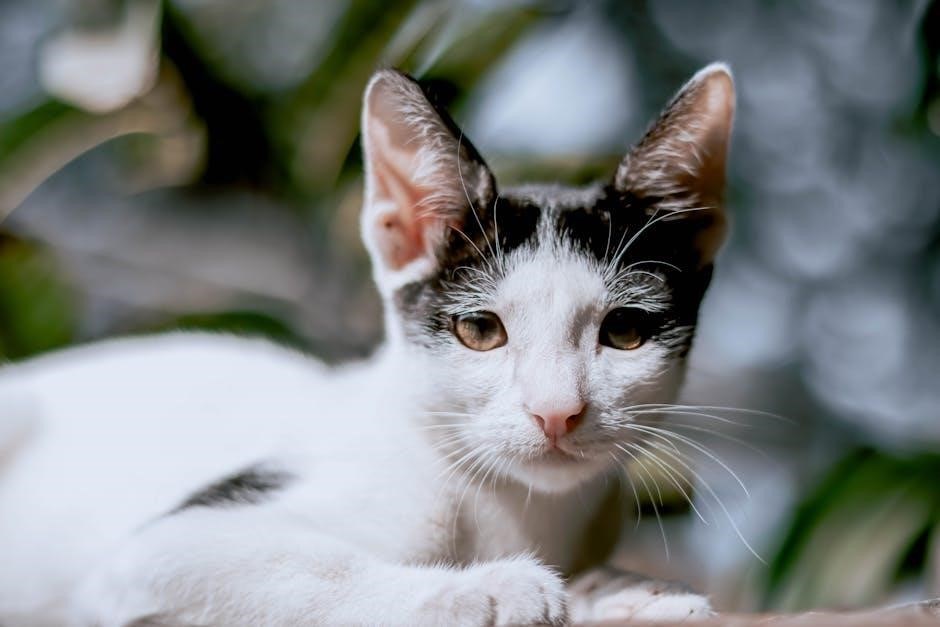
Writing Style and Literary Devices
Poe’s masterful use of suspense, foreshadowing, and dark imagery creates a haunting atmosphere, while his unreliable narrator adds complexity to the psychological exploration of guilt and madness.
6.1 Poe’s Use of Suspense and Foreshadowing
Poe masterfully employs suspense and foreshadowing in “The Black Cat” to create a chilling narrative. The story’s dark tone and the narrator’s unreliable perspective heighten tension, while subtle hints, like the black cat’s ominous presence, foreshadow tragic events. Poe’s meticulous pacing builds dread, as the reader anticipates the inevitable horrors. The mutilation of the cat and the subsequent appearance of another black cat with a white mark symbolize impending doom. These techniques engage readers emotionally, drawing them into the narrator’s descent into madness. The climax, with the discovery of the cat’s remains in the basement, is both shocking and inevitable, showcasing Poe’s skill in crafting a haunting, suspenseful tale.
6.2 The Impact of the Story’s Tone and Language
The tone of “The Black Cat” is dark, foreboding, and deeply unsettling, immersing readers in a world of psychological horror. Poe’s language is rich and evocative, crafting vivid imagery that enhances the story’s eerie atmosphere. The narrator’s voice, both detached and intense, adds to the psychological complexity, making the tale feel deeply personal and unnerving. Poe’s use of descriptive language for violent acts intensifies the emotional impact, while his mastery of pacing ensures a relentless buildup of tension. The story’s tone and language not only reflect the narrator’s spiraling madness but also amplify the themes of guilt, cruelty, and the supernatural, leaving a lasting impression on readers.
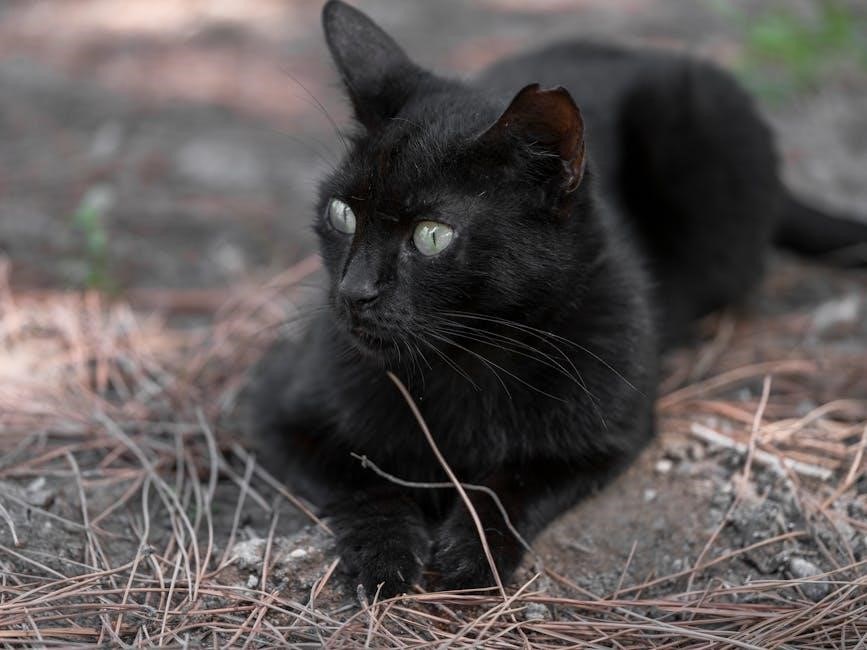
Historical Context and Cultural Significance
“The Black Cat” reflects 19th-century Gothic literature’s fascination with death, madness, and the supernatural, solidifying Poe’s legacy as a master of dark storytelling and cultural influence.
7.1 The Story’s Place in Gothic Literature
Edgar Allan Poe’s “The Black Cat” is a cornerstone of Gothic literature, blending elements of horror, the supernatural, and psychological complexity. The story’s dark, eerie atmosphere and themes of death, madness, and violence align with the genre’s traditions. Poe masterfully employs suspense and foreshadowing, creating a sense of dread that captivates readers. The narrative’s focus on the narrator’s unraveling psyche and the mysterious black cat as an omen of doom further solidifies its Gothic identity. By exploring the darker aspects of human nature, “The Black Cat” exemplifies the genre’s preoccupation with the macabre and the unknown, cementing its place as a seminal work in Gothic fiction.
7.2 The Influence of “The Black Cat” on Popular Culture
Edgar Allan Poe’s “The Black Cat” has left an indelible mark on popular culture, inspiring countless adaptations and interpretations. The story’s themes of guilt, madness, and violence have influenced films, literature, and art. Its iconic imagery, such as the black cat as a symbol of death, has been referenced in movies, TV shows, and music. The tale’s psychological depth has also inspired modern retellings and reimaginations, ensuring its relevance in contemporary media. Additionally, the story’s dark allure has made it a favorite at festivals and events celebrating Gothic culture, further cementing its influence on popular culture and entertainment.
Adaptations and Interpretations
“The Black Cat” has been adapted into films, TV shows, and stage plays, with each interpretation offering a unique perspective on Poe’s haunting tale of guilt and madness.
8.1 Film and Literary Adaptations of the Story
Edgar Allan Poe’s “The Black Cat” has inspired numerous film and literary adaptations, each capturing the eerie atmosphere and psychological depth of the original tale. Notable adaptations include the 1934 film starring Boris Karloff, which blended elements of “The Black Cat” with another Poe story, and the 1966 anthology film Torture Garden, featuring a segment based on the narrative. These adaptations highlight the story’s enduring appeal, translating its themes of guilt, madness, and violence into visual and dramatic forms. The availability of “The Black Cat” in PDF format has further facilitated its adaptation and reinterpretation, ensuring its influence across media and generations.
8.2 Modern Interpretations and Relevance

Modern interpretations of “The Black Cat” highlight its enduring relevance, as the story’s themes of guilt, madness, and violence continue to resonate with contemporary audiences. The tale’s exploration of psychological complexity and moral decay remains a focal point in academic and literary discussions. The availability of “The Black Cat” in PDF format has made it easily accessible, allowing new generations to engage with Poe’s work. Modern readers often draw parallels between the narrator’s unreliable perspective and current conversations about mental health and accountability. The story’s dark, suspenseful tone also influences modern media, from horror films to true-crime podcasts, ensuring its place in popular culture. Its timeless themes ensure its continued study and adaptation, solidifying its legacy in literature and beyond.
The Black Cat PDF: Availability and Access
The Black Cat short story PDF is widely available for free download from legal sources like Google Books, Project Gutenberg, and public domain repositories online.
9.1 Where to Find the PDF Version of the Story
The PDF version of “The Black Cat” can be easily found on various online platforms. Websites like Google Books, Project Gutenberg, and ManyBooks offer free downloads of the story in PDF format. Additionally, many public libraries provide access to digital versions through services like OverDrive or Libby. Users can also search for the story on academic databases or educational websites, which often include downloadable PDFs for study purposes. Ensure to use reputable sources to avoid copyright issues, as the story is in the public domain. Simply searching for “The Black Cat by Edgar Allan Poe PDF” on a search engine will yield multiple reliable options for download.
9.2 Legal and Free Sources for Download

Accessing “The Black Cat” in PDF format is straightforward and legal, as the story is in the public domain. Websites like Project Gutenberg, ManyBooks, and Google Books offer free, downloadable versions without copyright restrictions. Additionally, platforms such as the Library of Congress and Internet Archive provide high-quality PDFs for educational purposes. These sources ensure that readers can legally download and enjoy the story without infringing on copyright laws. Always verify the credibility of the website to avoid unauthorized or altered versions. With these options, readers can easily obtain a free and legal PDF of “The Black Cat” for personal or academic use.
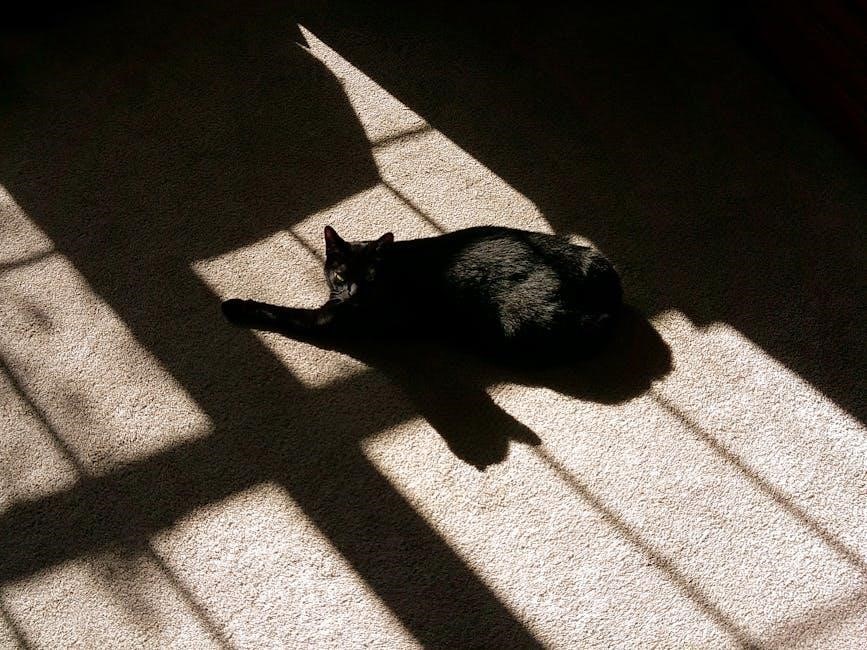
Study Guides and Analysis
Study guides for “The Black Cat” offer in-depth analysis of themes, symbols, and the narrator’s psyche. Resources like SparkNotes and LitCharts provide detailed insights for students and readers.
10.1 Key Questions for Discussion and Analysis
Discussing “The Black Cat” involves exploring its dark themes and symbolism. What role does guilt play in the narrator’s descent into madness? How does the black cat symbolize death or ill omen? Analyze the narrator’s reliability and the impact of his unreliability on the story. What motivates the narrator’s cruelty toward the cat and his family? How does Poe use suspense and foreshadowing to build tension? Examine the significance of the basement and its final revelation. What moral or ethical questions does the story raise? How does the story reflect Poe’s broader themes in his works? These questions encourage a deeper understanding of the narrative’s complexity and psychological depth.
10.2 Essay Topics and Research Ideas
Exploring “The Black Cat” offers rich opportunities for analysis. How does the black cat serve as a symbol of death and guilt throughout the story? Analyze the narrator’s psychological deterioration and its connection to his violent actions. Examine the role of suspense and foreshadowing in creating the story’s eerie atmosphere. Discuss the theme of cruelty and its consequences on both humans and animals. How does the story reflect Poe’s broader exploration of madness and the human psyche? What significance does the basement hold in the narrative, and how does it tie into the story’s climax? These topics invite deep exploration of Poe’s mastery of Gothic literature and psychological insight.
Poe’s “The Black Cat” remains a haunting exploration of guilt, madness, and violence, leaving a lasting impact on Gothic literature and popular culture with its chilling narrative.

11.1 Summary of the Story’s Impact and Legacy
Edgar Allan Poe’s “The Black Cat” has left an indelible mark on Gothic literature, exploring themes of guilt, madness, and violence with masterful suspense. Its haunting narrative continues to captivate readers, inspiring countless adaptations in film, literature, and popular culture. The story’s psychological depth and chilling tone have solidified its place as a cornerstone of horror, influencing writers and creators for generations. Its exploration of the darker aspects of human nature remains timeless, ensuring its relevance in modern discussions of morality and the human psyche. As a result, “The Black Cat” endures as a seminal work in American literary history, forever shaping the genre it helped define.
11.2 Final Thoughts on the Relevance of “The Black Cat”
Edgar Allan Poe’s “The Black Cat” remains a timeless masterpiece, its themes of guilt, madness, and the darker aspects of human nature continuing to resonate with modern audiences. The story’s psychological complexity and chilling narrative ensure its relevance in contemporary discussions of morality and the human condition. Its influence is evident in popular culture, from film adaptations to literary inspirations, solidifying its place in Gothic literature. The availability of “The Black Cat” in PDF format has made it accessible to a global audience, ensuring its enduring legacy. As a work that probes the depths of human psychology, it remains a vital read for both scholars and casual readers, offering insights into the shadows of the human soul.



